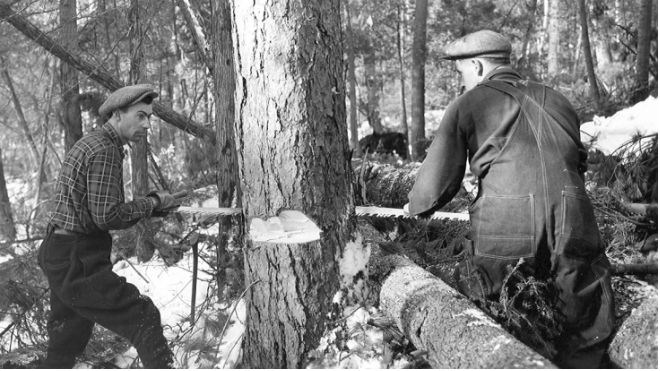The older we get, the more interesting history becomes.
Allan has taken a keen interest in the historic logging camps of the North. Whenever we are canoeing along a wilderness lake, he is on the lookout for those long-ago dwellings.
He can pick out the spot on shore from the middle of the lake. Generally, it will be where the land is relatively flat and the forest is mostly birch or poplar. We’ll stop for a look, and sure enough, nine times out of ten, we will find signs of previous occupation.
A hundred years ago, give or take a decade or two, loggers moved the trees to the mills via lakes and rivers. Remains of the dams they built at the outlet of every lake are still easy to see. More often than not, there will be less obvious evidence of buildings nearby.
Men would set up camps along the lake shore every five kilometres or so. This distance was determined by how far a man could reasonably walk to and from the cutting area each day. Most camps would have several buildings: stables, cookhouse, a bunkhouse or two, root cellar, to name a few.
Evidence of the outhouse remains are very long narrow trenches. Likely that building needed to serve a lot of men all at once. There was no time for waiting in line!
The building remnants at most sites have nearly faded back into the land. We find humps of dirt. Rotted buildings form rectangles and squares on the forest floor. The ‘buildings’ (such as they remain) can only be distinguished from fallen trees by the symmetry of the walls.
I like to spend time at the dams. As the water cascades through the rotting infrastructure, I try to imagine the past. How did they move those huge rocks? How long did it take to build these massive structures? How did they manage to drive the logs through the narrow channels and around the bends in the chasm? How many died in the process?
The loggers were not the only people to occupy the land and leave evidence of their camps behind. Prospectors had camps too. Usually just one or two buildings and a pile of broken quartz bits nearby.
Trappers had even smaller cabins, spaced just a few kilometres apart to give them shelter while snowshoeing the line in winter.
Still, these are just recent signs of occupation. Before loggers and prospectors and trappers, people lived here for several thousand years. Evidence of their lives – pre-contact – is harder to see. I have caught only a few glimpses and I want to learn more.
The older I get, the more interested I am in history.
Viki Mather has been commenting for Northern Life on the natural world and life in Greater Sudbury since the spring of 1984.
Join Sudbury.com+
- Messages
- Post a Listing
- Your Listings
- Your Profile
- Your Subscriptions
- Your Likes
- Your Business
- Support Local News
- Payment History
Sudbury.com+ members
Already a +member?
Not a +member?
Sign up for a Sudbury.com+ account for instant access to upcoming contests, local offers, auctions and so much more.
